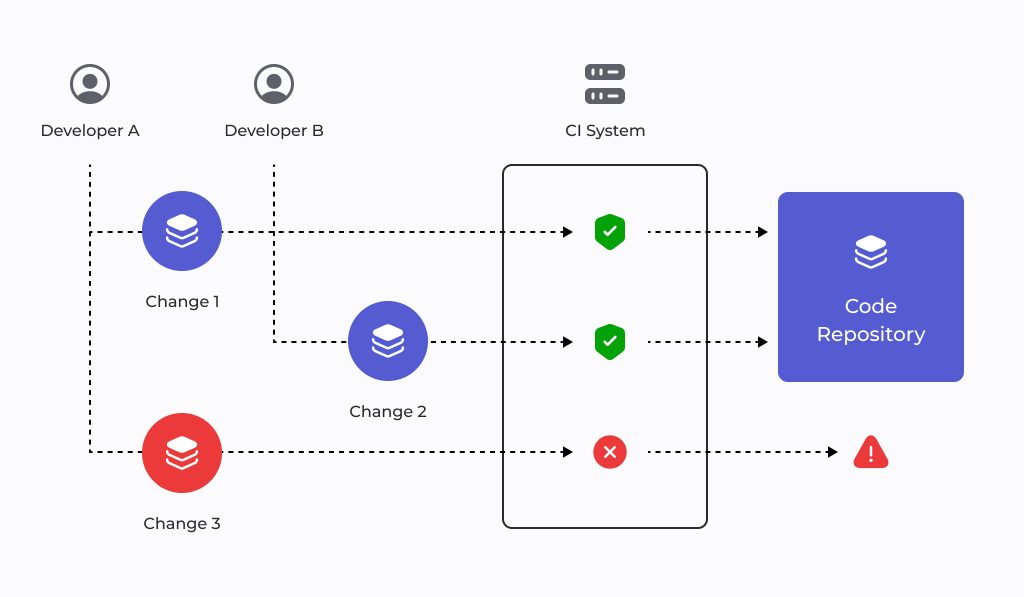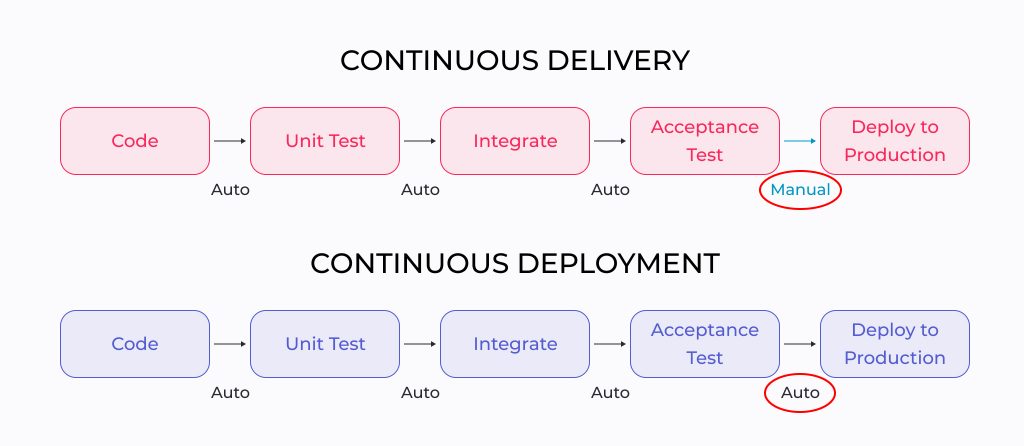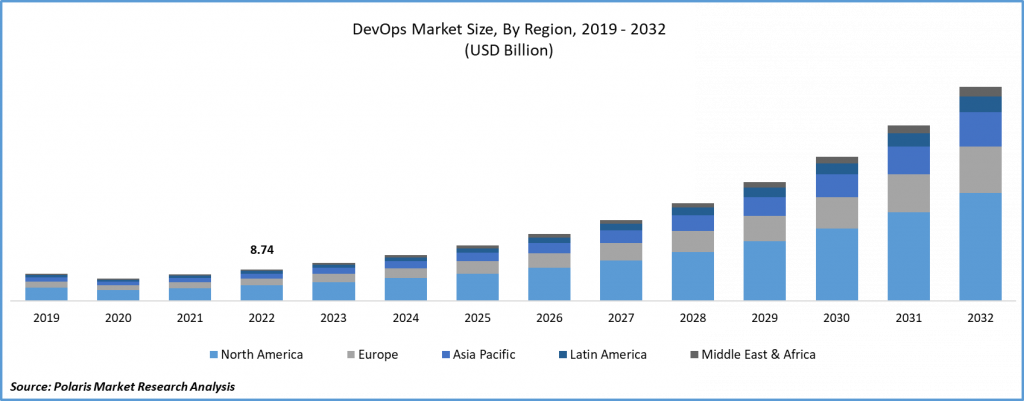The app's source code is where business ideas find their embodiment. However, for the end users to try the features, the code must go a long way from the idea to landing on the server. One of the possible solutions that allow development companies to fill the gap between writing code and putting it into production is DevOps. Today, we'll speak about what DevOps is, what critical practices it relies on, and what trends will rise in the future.
What DevOps is All About?
As the name suggests, DevOps services help bring together two groups of specialists working on the same project. Here, we speak of the web app development team and IT operations team. The application development team constantly introduces codebase changes that must be tested and pushed into production. It includes, for example, new features and bug fixes. On the other hand, the IT operations team primarily focuses on ensuring that the system is always stable and available. So, DevOps' primary role is to "reconcile" those who constantly push changes, increasing the risks of breaking something, with those whose duty is to minimize such risks.
So, DevOps here takes care of two vital characteristics. The first is velocity. In terms of software development, velocity means how fast products or apps can be piped through the release pipeline. The second one is quality. It's not enough to deliver the working app fast. Also, you must ensure that profound testing guarantees the quality of the product you deliver. Therefore, one must somehow balance quality and velocity.

Suppose you imagine the app development and delivery process as a chain of activities. In that case, we have Ideas (also known as the Planning or Ideation phase) at the very beginning of it. It represents the app features that should be delivered to add value to the business and its clients. The next step is Coding or Development. That's where programmers implement actual app features. Then we have the Build or Integration phase, where the code is packaged into executables and runtimes that will go to the next stage, where we Deploy them on some runtime environment, such as the cloud, for example. The Manage or Operations phase is about what happens to a web app after deployment. The last one in this line is Learning or Continuous Feedback, which is all about app improvement. We don't only need to define whether we move quickly enough through this chain but also check if the quality is improving or not.
Read Also Project Management Life Cycle Explained in Five Easy Steps
So, if we need to identify use cases for increasing velocity and quality during the app development and testing, we could highlight the following three primary examples:
Optimizing core systems. Here, we mean what’s deep within the enterprise. They're typically monolithic and legacy systems. Such apps are usually difficult to modernize or refactor. In these cases, the DevOps routine is generally about retrofitting automation on-site to optimize what you have;
Addressing the culture to help bring development and operations together;
Moving towards continuous improvements. The need for continuous delivery appears as SaaS solutions, Kubernetes, and Docker become more mature and widespread. Therefore, everything, from ideation at the beginning and all the way through, becomes a part of an improvement loop and rounds back to the beginning. This way, we can learn what we can do better when developing and testing our app and then feed this info back into the pipeline. By implementing practices like continuous integration and continuous delivery (CI/CD), teams can rapidly integrate code changes, automate testing, and deploy updates frequently.
DevOps Key Concepts And Useful Tools
As all steps involved in DevOps processes run in a loop to guarantee the balance between app quality and implementation speed, we often refer to some of the best practices as "continuous something." In this chapter, we'll share how various DevOps practices help improve the software development lifecycle and what tools engineers usually use.
Continuous Integration (CI)

Continuous integration (CI) is used during the Integration/Build phase mentioned in the previous chapter. Imagine that two developers are working in a small development team. They work on separate app features and write some new code or delete some old code to implement them. In a couple of months, they'll need to merge their code, which could cause problems. Say developers could introduce different changes to the same code blocks, write code that interferes with other parts of the app, or one of them could delete code written by the other. It leads to so-called merge conflicts and a wide variety of bugs. Imagine how complicated things could be if tens or hundreds of developers work with thousands of different files. In such a scenario, you can face "merge hell."
What's the possible solution here? The first programmer writes the code for the specific app feature, and as soon as something works without breaking the system, he submits it to the source control, even if the bigger feature still needs to be completed. The second developer can then pull this code before starting work and be sure he works on the latest version of it. The second programmer may introduce some changes, and when the first one comes back to work, he grabs this new version of the app code and deals with the same version of the code base. Now, the probability of them both working on the same thing without knowing about it is small, leading to lower risks of merge conflicts.
This approach works fine when only two people implement the app, but let's scale this up to a large company where everybody pulls new versions of code all the time. Here, to avoid countless bugs, some automation is required. When there's a new change, the system can perform unit testing, and if anything fails, it can notify team members. Plus, when the QA team needs to run some deeper testing, it'll always know that there's the latest app build that they know works.
Continuous Deployment vs. Continuous Delivery (CD). Balancing Speed and Control

The Integration and deployment phases rely on processes one may be confused with. We're speaking about Continuous Deployment and Continuous Delivery (CD). In both these development practices, you try to take new app code and move it to production as quickly as possible. So, the goal is to take your code, build it with a continuous integration tool, deploy it to a test environment, perform automated testing, and then move everything into production.
Continuous Deployment implies a swift transition of new app code into production environments, ensuring the rapid delivery of valuable updates. It originated in 2009. IMVU's approach of deploying to production 50 times daily, with minimal human intervention. The key to executing such frequent deployments lies in automation and rigorous testing. The robust testing suite encompassed thousands of tests across numerous servers, instilling confidence in the quality of the app code before deployment. Unlike continuous delivery, continuous deployment mandates all-encompassing automation from code inception to production release. This app development approach demands a substantial investment in testing infrastructure and a cultural shift toward embracing automation-driven workflows.
Most organizations choose a more cautious approach called Continuous Delivery that automates processes until the final testing phase but retains a human decision. This intermediary development technique balances automation and human oversight, allowing development companies to streamline their pipelines while maintaining regulatory adherence and risk management protocols.
Continuous Integration and continuous delivery (CI/CD) tools:
Jenkins ;
CircleCI;
Spinnaker;
ArgoCD.
Continuous Testing
Continuous software testing embodies the approach with rapid feedback as one of the main focus points. It facilitates the seamless integration of changes and fosters a culture of agility essential for DevOps principles and continuous delivery. DevOps teams emphasize unit testing and API testing to address such challenges as the tension between testing comprehensiveness and responsiveness to market demands. Unit testing ensures robustness at the code level and fosters a foundation of stability amid iterative development cycles. API testing emerges as a linchpin in the era of microservice apps, safeguarding the integrity of interconnected systems and mitigating the risk of cascading failures.
Despite the importance of automation, manual app testing also has an indispensable role. Exploratory testing, conducted by expert QA teams, is crucial for uncovering latent defects and validating user experiences beyond scripted scenarios. Additionally, user acceptance testing, or beta testing, provides invaluable insights into real-world usability and ensures the alignment of software with end-user expectations.
Test automation frameworks:
Selenium;
Appium;
Katalon;
Robot Framework;
Serenity (formerly known as Thucydides).
Future DevOps Trends
Let’s start with some statistics. According to the DevOps Market Share, Size, Trends, Industry Analysis Report, the global DevOps market was valued at $10.5 billion in 2023 and is expected to grow at a CAGR of 21.20% from 2024 to 2032:

The following factors dictate such a growth:
Need for scalability;
Recognition of DevOps importance within the industry;
Established best practices;
Maturity of DevOps tools and techniques;
Necessity for continuous integration and deployment.
The upcoming rise in demand for DevOps will change how engineers implement it. Let's consider some trends we'll witness in the future.
No-code/Low-code DevOps Tools
Imagine a world where complex DevOps tasks are as easy as dragging and dropping. No-code/low-code tools are making this a reality. These user-friendly platforms empower individuals with minimal coding experience to participate in the DevOps lifecycle. It allows focusing on core functionalities while citizen developers, business analysts, or operations specialists can automate deployments, manage infrastructure, and streamline workflows.
Read Also No-code, Low-code, and Pro-code Development. How to Choose Your Place on the Spectrum
Shift-Right Testing
Traditionally, testing has been heavily focused on the early stages of development. However, the trend is shifting towards "shift-right testing." This approach emphasizes extending robust testing practices throughout the entire pipeline, including production monitoring. By continuously testing in production environments, development teams can identify and fix issues faster, leading to a more stable and reliable user experience.
The Rise of Site Reliability Engineering (SRE)
SRE is a DevOps philosophy that bridges the gap between development and operations. SRE teams focus on building and maintaining highly reliable, scalable software systems. In the future, we'll see a broader adoption of SRE principles, focusing on automating infrastructure management, proactive problem identification, and data-driven decision-making. It will lead to increased system uptime, reduced downtime costs, and improved overall application performance.
Read Also Site Reliability Engineering And Its Impact on Software Quality
Event-Driven Architectures
Traditional monolithic apps are giving way to event-driven architectures (EDA). EDA breaks down complex systems into smaller, independent services communicating through asynchronous events. This approach fosters loose coupling, scalability, and increased resilience. As DevOps teams embrace EDA, they can expect faster deployments, easier maintenance, and a more responsive infrastructure that adapts to changing demands.
Maturation of DevOps Toolchains
DevOps is not a single tool but a set of tools and practices working in concert. The future will see a continued maturation of DevOps toolchains, offering a more integrated and user-friendly experience. These toolchains seamlessly connect various DevOps stages, from code versioning to CI/CD pipelines and infrastructure management. It will streamline workflows, reduce complexity, and allow app development teams to focus on delivering innovative solutions.
AI and DevOps
With all the fuss around AI development, it is not surprising that DevOps is also affected. As we already figured out, DevOps relies heavily on automation. Specific tasks that were always pretty time-consuming (e.g., crafting backup scripts or porting something from one language to another) can largely be done by AI. It's always the responsibility of a human DevOps specialist to ensure that everything runs correctly, but AI can dramatically speed up everything compared to generating all the code from scratch. And it's pretty exciting for DevOps engineers who may not feel like people who must write the same amount of code as software engineers.
DevSecOps And Shift-Left
When security teams collaborate with developers on the policy as code, it helps build trust between the teams and boosts confidence in the modifications being implemented. Incorporating DevSecOps encourages development teams to handle security issues earlier in the software development life cycle, often referred to as a shift-left approach. This strategy helps to lower the risks and expenses associated with fixing vulnerabilities that might only become apparent after the app is finished or already in use. More importantly, it helps prevent security breaches that could expose sensitive customer and business data, saving us from potentially massive costs and widespread.
Key Insights to Improve Your Organization’s DevOps
Foster a collaborative culture of shared success. DevOps thrives on collaboration. It's more than just breaking down silos between development and operations. Cultivate an inclusive, cohesive, and generative culture where team members from all disciplines feel empowered to share ideas, learn from each other, and work towards a common goal. This collaborative spirit fosters innovation, problem-solving, and a sense of ownership within the team.
User-centric design for enhanced value delivery. Keep sight of the end user. Embed a user-centric mindset throughout your DevOps lifecycle. Incorporate user feedback early and often in the development process. It ensures that the features you build address user needs and pain points. Prioritizing user experience fosters the development of high-quality products that resonate with users, ultimately driving customer satisfaction and business growth.
Empower teams with comprehensive documentation. Quality documentation is the lifeblood of efficient DevOps practices. Invest in creating and maintaining clear, concise, and up-to-date documentation. It includes everything from code comments to deployment procedures to infrastructure configurations. Easy-to-understand documentation empowers team members to be self-sufficient, reduces onboarding time for new hires, and minimizes errors during deployments and maintenance tasks.
Foster equitable work distribution and prevent burnout. DevOps is a collaborative effort, but it's crucial to ensure fair and equitable workload distribution. Repetitive tasks can lead to burnout, hindering team morale and productivity. Studies have shown a strong correlation between increased burnout and individuals who shoulder a disproportionate share of repetitive tasks. Utilize automation tools to streamline repetitive tasks and ensure underrepresented groups within the team are not unfairly burdened.
Embrace the cloud for scalability and agility. Cloud development offers unparalleled flexibility and scalability, making it a valuable tool for DevOps teams. Leveraging cloud-based infrastructure allows your development team to quickly provision resources, scale apps based on demand, and automate deployments. The cloud empowers DevOps engineers to respond more to changing business needs and deliver software faster.
Conclusions
DevOps is one of the embodiments of modern software development. In the case of the waterfall model, typical for the pre-2000s era, app development and testing could postpone new software releases for months or even years. Modern agile development practices imply an iterative approach where frequent releases and feedback are crucial. Thus, DevOps practices fit perfectly with the robust app development and testing methodologies that most companies use nowadays.
